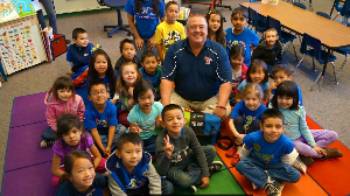John D. Welty Center for Educational Policy and Leadership
Blog for Leaders Facing Challenges
Blog Index

The Teacher is Key
By: Shirley Stiles
A few years ago I attended a conference on Peace. One of the speakers worked at the UN and was not an educator. He told us how he envied educators because, “We are the only ones who in our professional lives on a daily basis have the privilege of “teaching the future”. That really says it all for me, that’s quite a responsibility and a real privilege.
The Teacher is the Key to student learning and success. I would like to clarify that when I say “teacher” I mean it in the broadest sense – every adult in the school building is a teacher – they all teach – through modelling behaviour – they represent society to students: custodians, support staff, administrators, and teachers.We model society’s expectations of education, of learning, and attitudes to students.
The ways you interact with students, the ways you interact with each other, the ways you model for students, and the ways you teach in your classrooms – that’s what creates the school climate. These are very tough challenges that happen every day of the school year.
Teachers are such key role models – next to student peers and parents, you are key! It is so easy to get caught up in the day-to-day issues. Instead, ask yourself:
- How many students did I interact with this week to congratulate them on their good attendance, academic achievements, athletic achievements, citizenship?
- How many students did I have in for a brief one-on-one?
- How many students have I interacted with this week that I haven’t interacted with before?
- How many students have I talked to regarding their concerns?
A few years ago I attended a conference on Peace. One of the speakers worked at the UN and was not an educator. He told us how he envied educators because, “We are the only ones who in our professional lives on a daily basis have the privilege of “teaching the future”. That really says it all for me, that’s quite a responsibility and a real privilege.
Although classrooms are currently closed, students are still needing to learn. Your responsibility has not disappeared but the challenges for you as a teacher have taken a quantum leap. Take the challenge, be innovative, and remember that all of those expectations of you as a teacher are still there in each of your students.
Keep teaching! The Teacher IS the Key!
Full article available at https://sstilesconsulting.wordpress.com

Distance Learning: An Opportunity to Strengthen Our Collaboration!
By: Marc Johnson
These are times unlike any we have faced in our careers, but they also are quite possibly the most profound leadership growth opportunity we have ever been provided, as well. Teacher leader
ship within grade level and subject matter teams during this time is essential. Effective and focused team collaboration is needed to generate the learning opportunities for our students and support them through difficult changes. Now is the time to deepen our collaborative culture, not abandon it!
Have we reminded ourselves what real collaboration is, and do we see this as an opportunity to grow? Collaboration is not a meeting; it is a process, and if we embrace that concept, we then understand that powerful collaboration can occur even in a time of shelter in place and social distancing.
Teams may have members who struggle with technology and we are behind the curve in our professional development here; how do we overcome that deficit quickly? Use the team to build the team! A team is a group of people working together interdependently to achieve a common goal for which they are mutually accountable! Building on that concept of team to address the gaps that some staff have in utilizing technology effectively,
How do we assure that we are focused on LEARNING in the time we have left this year, and not just keeping kids busy at home? The first big idea of a Professional Learning Community is an absolute, relentless commitment to learning! It is essential that we make sure our teams are developing a collective commitment to supporting the learning of their students and keeping their collaboration anchored in and driven by that commitment! We also need to be careful that we are not overloading our kids and overwhelming our parents during this time as well. Finally, we have to define the learning that must happen between now and the end of the year to lay the foundation for next year!
Are we taking advantage of the opportunity to actually develop a stronger culture of collaboration and a commitment to learning? This time will impact our culture, either with us or without us. We can “cultivate” a stronger collaborative culture or we can simply let things evolve and hope we can pick up the pieces when things get back to “normal”! Living in an agricultural region, we understand cultivation is an ongoing process, not a “one and done” event! If you have ever grown a garden, you know that if you go on vacation for two weeks, there will be weeds in the garden. If we don’t “cultivate” a stronger collaborative culture during this time, we will have weeds in our garden, so how are we “tending our garden”?
I have heard of some systems where there has been pushback and resistance to action because not all kids had access to the learning. Equity is not something that is achieved by waiting for it; equity is achieved and becomes our reality through action! We have to see this as a journey of improvement and realize that on a journey of improvement, there is no place on the pathway called “good enough”. Use each day as a building block for a better tomorrow!
Every child, every day, whatever it takes!
On behalf of the kids you serve, thank you for your passion and persistence! Lead
with courage and with heart! Tend the garden!
Full article available at https://www.solutiontree.com/blog/
Two Ways to Avoid Falling into the RTI Rebranding Trap
By: Jessica Hannigan and John Hannigan
First came RTI, then RTI², and now there’s MTSS.
What’s different? What changed?
As we support schools across the country, we are faced with many districts, even state departments of education who treat RTI as a bad word, rather than taking an honest look at the understanding, misconceptions, and implementation errors.
We’ve heard, “Whatever you do, don’t call it RTI; we call it MTSS now,” or “RTI is a bad word in our state, and Tier III is only for special education.” We can go on and on with a long list of misconceptions. Unfortunately, new names (what we refer to as “rebranding”) for essentially the same initiative simply clouds implementation, leads to additional misconceptions, and muddies the water even further.
We will use this commonly asked question to guide our case: How is RTI² different from RTI/MTSS? (We use RTI and MTSS interchangeably.)
The answer to this question is pretty straightforward: RTI/MTSS and RTI² are not different. If schools across the country were implementing RTI correctly initially, there would be no need to add to or change terminologies to make it seem “more comprehensive.” The answer to this question is not an attempt to make provocative statements or elicit emotional responses from those with strong feelings toward one definition over the other. It is simply to help educators avoid falling into the RTI rebranding trap we have seen much too often.
Here are two ways to avoid falling into this RTI rebranding trap.
1. Understand the definition and key components of RTI before adopting the same thing with a different name.
First, let’s look at one example of similarities and differences between California’s MTSS and RTI² processes from the California Department of Education in Table 1.1 below.
Keep in mind, this is one example of the lack of clarity around this topic that is happening similarly in other states across the country. Also keep in mind, although we use MTSS and RTI interchangeably, it does not necessarily mean California does. In fact, in this particular example, you will see how MTSS is compared to RTI² , and there is no mention of RTI; yet all of the key components highlighted in MTSS and RTI² are and always have been a part of an effective RTI framework.
Table 1.1: CDE MTSS and RTI² Comparison
| Comparison MTSS Differences with RTI² | MTSS Similarities to RTI² |
|---|---|
|
MTSS has a broader scope than does RTI². MTSS also includes:
|
MTSS incorporates many of the same components of RTI², such as:
|
According to the similarities listed in the above example, both rely on RTI data-gathering through universal screening, data-driven decision making, and problem-solving teams, and are focused on the Common Core State Standards. However, it is stated that the MTSS process has a broader approach, addressing the needs of all students by aligning the entire system of initiatives, supports, and resources, and by implementing continuous improvement processes at all levels of the system.
We respectfully disagree that this is a new concept. We would argue that any current-model RTI school would also have such structures firmly in place for both academics and behavior; hence, why we use RTI/MTSS interchangeably. Based on this comparison example, it is clear there is a disconnect/misunderstanding of the core components of RTI, which has led to this progression of rebranding the terms from RTI, RTI², and now MTSS.
Full article available at https://www.solutiontree.com/blog

Leadership Coaching for Principals: A National Study
By: Donald Wise and Blanca Cavazos
Introduction
The responsibilities of a public school principal have changed radically in the past few years since the enactment of the No Child Left Behind Act of 2001 (Bossi, 2007; Fullan, 2002; Jenkins & Scott, 2012; Knapp, 2008; Marlow, 2014; Murphy, 2015). A recent national survey found, “Most principals say that t
heir responsibilities today have changed compared to five years ago and that the job has increased in complexity” (MetLife, 2013, p. 23). The principal must not only be an effective manager of operations and resources, but must also be a strong instructional leader. The principal is also required to be knowledgeable about current curriculum and instructional practices that lead to high student achievement and to be well-informed of the implications of implementing the Common Core State Standards (Davis, Darling-Hammond, LaPointe, & Meyerson, 2005; Gewertz, 2012; Marzano, Waters, & McNulty, 2005; Wise & Jacobo, 2010). Accountability has also changed. The No Child Left Behind Act, “Require(s) such entity to replace educational personnel relevant to the entity’s failure to meet such objectives” (NCLB, 2001, Section 3122 (b) (4) (B) (ii)).
The central role of the principal in bringing about change and increasing student achievement has been well documented in the literature (Hallinger & Heck, 1996; Leithwood, Seashore, Anderson, & Wahlstrom, 2004; Leithwood & Day, 2008; Leithwood & Wahlstrom, 2008; Marzano et al., 2005; Shirrell, 2016; Wallace Foundation, 2013). Researchers of school leadership generally find that, “Principals are the key factor in building and sustaining a school culture in which both teachers and students can succeed” (MetLife, 2013, p. 23). In a recent study, Branch, Hanushek, and Rivki (2013) used “value-added” methodology and found that “highly effective principals raise the achievement of a typical student in their schools by between two and seven months of learning in a single school year; ineffective principals lower achievement by the same amount” (para 3).
Such a pivotal role in school performance requires support. It is in a principal’s performance where leadership coaching makes a positive impact. Noble (2012) stated, “In its simplest form, coaching is the act of helping others to perform better” (p. 32). While coaching has been well established in the sports and business worlds for some time as a means to enhance performance (Bono, Purvanova, Towler, & Peterson, 2009; Hamlin, Ellinger, & Beattie, 2006; Whybrow, 2008), its introduction into the education arena has been primarily through the coaching of teachers (Knight, 2009). Leadership coaching in education is an even more recent phenomenon (Aguilar, Goldwasser, & Tank-Crestetto, 2011; Goff et al., 2014; Reeves, 2009; Reiss, 2006).
Theoretical underpinnings of coaching
Hargrove (2008) stated that the main purpose of a leadership coach is (a) to expand an individual’s or group’s capacity to obtain desired results and (b) to facilitate individual or organizational development. Both of these purposes relate to Bandura’s (1986, 1997) social cognitive theory and extensive work in the area of self-efficacy. Bandura’s four sources of self-efficacy provide insights into how leadership coaching helps school principals build capacity through what Bandura terms as modeling, social persuasion, physiological factors, and mastery experiences. Simply stated, in the work of a leadership coach, the coach models for the principal appropriate ways to approach issues and to select and carry out actions. As the principal develops these skills, the coach offers continual feedback and motivation for the principal’s progress and accomplishments (social persuasion). As skills increase, the principal experiences success (mastery experiences) and a higher sense of self-efficacy. The principal with a higher sense of self-efficacy will tend to view physiological factors, such as nervousness before addressing a faculty meeting, as normal and not an indication of a lack of ability (Bandura, 1986, 1997).
However, Bandura (1986) found that if a task was too simple, little sense of self-efficacy would result. This is where Vygotsky’s (1978) Zone of Proximal Development (ZPD) offers further understanding of coaching. The coach must provide support (“scaffolding”) and push the principal sufficiently out of their Zone of Comfort into the ZPD where the principal has to fully engage and stretch their capacity. The ZPD is where learning is maximized (Vygotsky, 1978) and creates mastery experiences (Bandura, 1986). Indeed, coaching has been seen as expanding or “stretching” the client’s knowledge, skills and actions (Daniels, Cole, & Wertsch, 2007).
Another important theoretical underpinning comes from the work of Argyris and Schon (1978) on organizational learning. These authors wrote of single, double, and triple-loop learning, concepts that have been expanded upon by Senge (1990) and others (Kahane, 2004; Senge, Cambron-McCabe, Lucas, & Kleiner, 2000).
Single-loop learning indicates simply making small adjustments to resolve a problem. In essence, it involves a simple behavioral change. Single loop learning is a common way that principals make decisions. Double-loop learning, on the other hand, questions the governing variables involved and comes into play for principals who seek long-term solutions by reframing the thinking process of decision-making. Leadership coaching can be effective when principals engage in double-loop learning. Triple-loop learning involves a transformation of the principal’s perceptions (Kahane, 2004) and is present when the principal steps back to analyze context and examines how past behavior and decisions have led to the current state of being. It is through effective dialog and reflective questioning that a coach can help a principal reflect more purposefully about decision-making and affect greater, long-term professional growth.
Full study available at https://www.tandfonline.com/eprint/hBSxfYWxNAUCwwJSNUAu/full